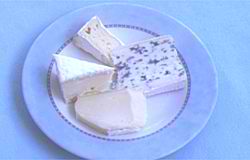the story of rocquefort cheese
According to the stories and
legends of the Roquefort region in south central France--about 2000 years ago a young
shepherd tending his sheep high in the Causses [high arid mesa's similar to those in
Arizona or Mexico], was concerned about the effect of the fiery sun on his lunch of rye
bread, white sheep's milk cheese and apples. He noticed that along one side of this mesa
there was a high mass of rock, known today as Mount Combalou, tunneled with many dark
caves. The shepherd climbed up and left his lunch on a cool ledge in the deep shade of one
of the caves, safe from the sun.
Shortly afterwards his flock was attacked by a wolf and he forgot about his lunch
altogether until three months later he climbed back into the cave. He was not surprised to
find his bread and apples moldy and inedible, but the white cheese was interestingly shot
through with jagged blue/green veins. When he tried this strange cheese which had remained
perfectly soft he found it had an interesting aroma and a faint nutty,
definitely tangy
flavour. He took this cheese home. All his family enjoyed it as well. Roquefort was born.
The cheese gets its name from the fact that only Mount Combalou was found to have the
power of creating the blue/green veins. Other caves some only a mile away had no effect.
Since the cheeses came from a fortress like rock it was simply called "Roc
Fort".
The veins are in fact caused by the "benign and noble" mold, Penicillium
roquefortii which is apparently found nowhere else in the world.
